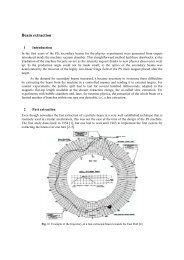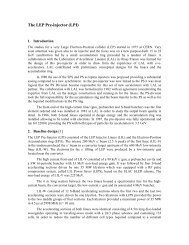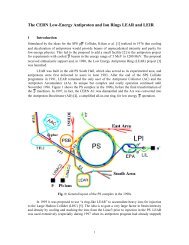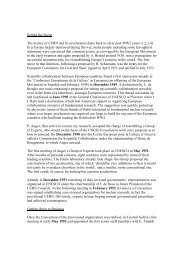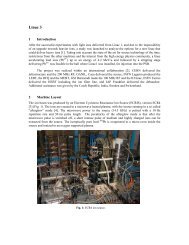RF gymnastics in the PS - CERN
RF gymnastics in the PS - CERN
RF gymnastics in the PS - CERN
Create successful ePaper yourself
Turn your PDF publications into a flip-book with our unique Google optimized e-Paper software.
5 Protons for <strong>the</strong> LHCThe lum<strong>in</strong>osity goals <strong>in</strong> <strong>the</strong> LHC require proton beams with a brightness exceed<strong>in</strong>g <strong>the</strong> exist<strong>in</strong>gcapabilities of <strong>the</strong> L<strong>in</strong>ac2–<strong>PS</strong>B–<strong>PS</strong>–S<strong>PS</strong> cascade. An upgrade was <strong>the</strong>refore launched [21] based onthree ma<strong>in</strong> <strong>in</strong>gredients: (i) division by 2 of <strong>the</strong> beam brightness <strong>in</strong> <strong>the</strong> <strong>PS</strong>B by <strong>the</strong> use of two pulses tofill <strong>the</strong> <strong>PS</strong>, (ii) division by 1.5 of space-charge tune spread <strong>in</strong> <strong>the</strong> <strong>PS</strong> by <strong>in</strong>creas<strong>in</strong>g <strong>the</strong> <strong>in</strong>jection energyto 1.4 GeV, and (iii) suppression of <strong>the</strong> transition bottle neck <strong>in</strong> <strong>the</strong> S<strong>PS</strong> by <strong>in</strong>ject<strong>in</strong>g at 25 GeV. Thelongitud<strong>in</strong>al stack<strong>in</strong>g of two <strong>PS</strong>B batches <strong>in</strong> <strong>the</strong> <strong>PS</strong> is made possible by hav<strong>in</strong>g a s<strong>in</strong>gle bunch <strong>in</strong> each<strong>PS</strong>B r<strong>in</strong>g, operat<strong>in</strong>g <strong>the</strong> <strong>RF</strong> on h=1, and chang<strong>in</strong>g to <strong>the</strong> beam transfer scheme sketched <strong>in</strong> Fig. 18.The harmonic number also had to be changed <strong>in</strong> <strong>the</strong> <strong>PS</strong>, and <strong>the</strong> <strong>in</strong>itial choice was for h=8.Fig. 18: <strong>PS</strong>B–<strong>PS</strong> beam transfer before and after modification for <strong>the</strong> LHCS<strong>in</strong>gle-batch fill<strong>in</strong>g of <strong>the</strong> <strong>PS</strong> rema<strong>in</strong>s possible, with two bunches per <strong>PS</strong>B r<strong>in</strong>g (<strong>RF</strong> on h=2)and <strong>RF</strong> on h=8 <strong>in</strong> <strong>the</strong> <strong>PS</strong>. Once implemented at <strong>the</strong> beg<strong>in</strong>n<strong>in</strong>g of 1998, all beams delivered by <strong>the</strong> <strong>PS</strong>had to be modified to operate with new harmonic numbers and revised <strong>gymnastics</strong> [22]. In particular,<strong>the</strong> <strong>in</strong>verse process to merg<strong>in</strong>g pairs of bunches, splitt<strong>in</strong>g bunches <strong>in</strong>to two, became rout<strong>in</strong>e operation[23].Beyond beam brightness, <strong>the</strong> <strong>PS</strong> also has to give its f<strong>in</strong>al time structure to <strong>the</strong> proton beam,for example transform<strong>in</strong>g it <strong>in</strong>to a 40 MHz bunch tra<strong>in</strong> (25 ns spac<strong>in</strong>g between bunches) <strong>in</strong> <strong>the</strong>nom<strong>in</strong>al case. Debunch<strong>in</strong>g on h=16 followed by rebunch<strong>in</strong>g on h=84 (40 MHz) at 25 GeV was <strong>the</strong>process <strong>in</strong>itially foreseen for that purpose (Fig. 19) [21]. A fixed-tune 40 MHz <strong>RF</strong> system was<strong>the</strong>refore built and <strong>in</strong>stalled <strong>in</strong> <strong>the</strong> <strong>PS</strong> <strong>in</strong> 1996 [24]. It was complemented <strong>in</strong> 1998 with an 80 MHz <strong>RF</strong>system [25] to allow for <strong>the</strong> bunch rotation necessary to reduce bunch length down to 4 ns, as requiredby <strong>the</strong> S<strong>PS</strong>. All of <strong>the</strong>se cavities are equipped with a telescopic mechanical short-circuit which almostperfectly closes <strong>the</strong>ir gaps when <strong>the</strong>y are not <strong>in</strong> use (Fig. 20). Although open<strong>in</strong>g and clos<strong>in</strong>g takeapproximately one second, movements are planned to take place only a few times per day,immediately before and after fill<strong>in</strong>g <strong>the</strong> LHC. In addition, a fast <strong>RF</strong> feedback is implemented on bothsystems to m<strong>in</strong>imize impedance when <strong>the</strong> gap is open.10



